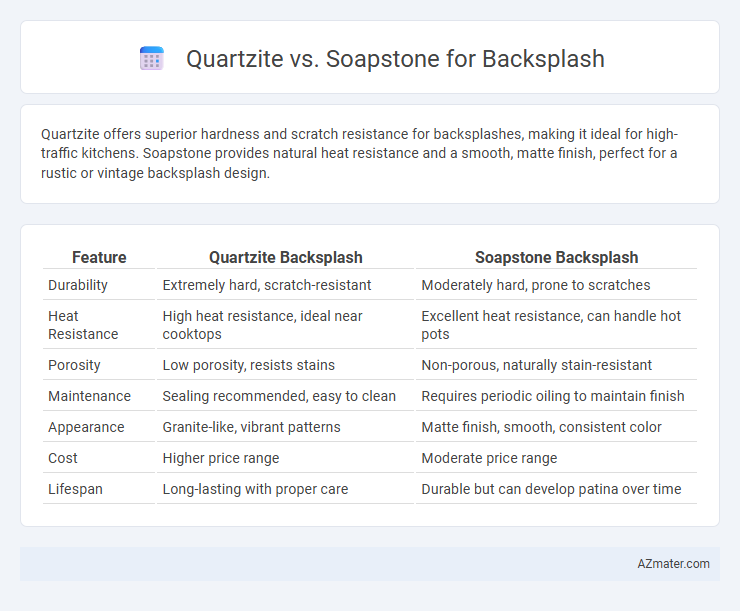Quartzite offers superior hardness and scratch resistance for backsplashes, making it ideal for high-traffic kitchens. Soapstone provides natural heat resistance and a smooth, matte finish, perfect for a rustic or vintage backsplash design.
Table of Comparison
| Feature | Quartzite Backsplash | Soapstone Backsplash |
|---|---|---|
| Durability | Extremely hard, scratch-resistant | Moderately hard, prone to scratches |
| Heat Resistance | High heat resistance, ideal near cooktops | Excellent heat resistance, can handle hot pots |
| Porosity | Low porosity, resists stains | Non-porous, naturally stain-resistant |
| Maintenance | Sealing recommended, easy to clean | Requires periodic oiling to maintain finish |
| Appearance | Granite-like, vibrant patterns | Matte finish, smooth, consistent color |
| Cost | Higher price range | Moderate price range |
| Lifespan | Long-lasting with proper care | Durable but can develop patina over time |
Introduction to Quartzite and Soapstone
Quartzite, a natural metamorphic rock known for its durability and resistance to heat and scratches, presents a stunning option for backsplashes with its quartz-rich composition and vibrant, crystalline patterns. Soapstone, composed primarily of talc, offers a softer, smooth surface with excellent heat resistance and the unique ability to develop a rich patina over time, ideal for kitchens seeking a rustic, warm aesthetic. Both materials provide distinct textures and color variations, making them popular choices for functional and visually appealing backsplash installations.
Key Differences Between Quartzite and Soapstone
Quartzite is an extremely hard natural stone composed mainly of quartz, offering exceptional durability and resistance to scratching, making it ideal for high-traffic backsplash areas. Soapstone, composed primarily of talc and magnesium silicate, is softer and more prone to scratches but excels in heat resistance and develops a unique patina over time. Quartzite typically requires less maintenance and resists staining more effectively than soapstone, which benefits from regular oiling to preserve its appearance.
Appearance and Aesthetic Appeal
Quartzite offers a striking, natural stone look with crystal-like veining and a glossy finish that enhances backsplash areas with vibrant, elegant patterns. Soapstone provides a smooth, matte surface with subtle color variations in muted tones of gray, green, or brown, delivering a soft, timeless aesthetic ideal for rustic or contemporary kitchens. Both materials are durable and stain-resistant, but quartzite's polished sheen creates a more luxurious visual impact compared to soapstone's understated, vintage charm.
Durability and Strength Comparison
Quartzite offers superior durability and hardness, ranking between 7 and 8 on the Mohs scale, making it highly resistant to scratches and heat, ideal for backsplashes in high-traffic kitchens. Soapstone, while softer with a Mohs hardness of around 2.5 to 4, excels in resistance to stains and acids, offering excellent longevity despite being more prone to dents and scratches. For backsplashes requiring maximum strength and impact resistance, quartzite is the preferable choice, whereas soapstone suits environments where chemical resilience is prioritized.
Maintenance and Cleaning Requirements
Quartzite backsplashes offer high durability and resistance to stains, requiring only regular sealing every 1 to 2 years to maintain their appearance and protect against moisture. Soapstone, known for its non-porous nature, resists stains and bacteria without the need for sealing, making cleaning simple with mild soap and water. Both materials are easy to maintain, but soapstone's natural resistance to acids and heat provides a low-maintenance option ideal for busy kitchen environments.
Stain and Heat Resistance
Quartzite offers excellent heat resistance, making it ideal for areas near stoves or heat sources, while its natural composition provides strong stain resistance, especially when properly sealed. Soapstone, though highly heat resistant and known for its ability to withstand direct flame and hot pots, is more porous and prone to staining unless regularly treated with mineral oil or sealants. Both materials require maintenance to preserve their appearance, but quartzite generally demands less frequent sealing to maintain stain resistance compared to soapstone.
Installation Considerations
Quartzite backsplashes require professional installation due to their hardness and brittleness, which make cutting and shaping challenging without specialized tools. Soapstone, being softer and more workable, allows for easier custom cuts and installation, often suitable for DIY projects. Both materials demand proper sealing to prevent staining, but soapstone's non-porous nature typically requires less frequent maintenance post-installation.
Cost Comparison and Budget Factors
Quartzite backsplashes generally cost between $50 to $100 per square foot, making them a higher-end option compared to soapstone, which ranges from $30 to $75 per square foot. Soapstone's lower price point and ease of maintenance make it a budget-friendly choice for homeowners looking to balance aesthetics with affordability. Both materials offer durability, but quartzite's price reflects its natural stone hardness and unique veining, often influencing budget decisions for upscale kitchen designs.
Environmental Impact and Sustainability
Quartzite is a natural metamorphic rock with a relatively low environmental impact, as it requires minimal chemical processing and is highly durable, reducing the need for frequent replacement in backsplashes. Soapstone, composed primarily of talc, is also environmentally friendly due to its natural formation and ease of recycling, and it has a longer life cycle because of its resistance to heat and stains. Both materials contribute to sustainable kitchen design choices, but soapstone's softer mining process and less energy-intensive finishing make it a slightly more eco-conscious option for backsplashes.
Which Stone is Best for Your Backsplash?
Quartzite offers exceptional durability and resistance to heat and scratches, making it ideal for high-use kitchen backsplashes. Soapstone provides a smooth, non-porous surface that resists stains and requires minimal maintenance but is softer and more prone to dents. Choose quartzite for a hard-wearing, elegant backsplash or soapstone for a low-maintenance, rustic aesthetic.

Infographic: Quartzite vs Soapstone for Backsplash
 azmater.com
azmater.com